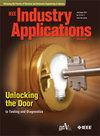Design and Optimization of High-Efficiency Coreless PCB Stator Axial Flux PM Machines With Minimal Eddy and Circulating Current Losses
IF 4.2
2区 工程技术
Q2 ENGINEERING, ELECTRICAL & ELECTRONIC
引用次数: 0
Abstract
This paper proposes a systematic multi-step design procedure for highly efficient printed circuit board (PCB) stator coreless axial flux permanent magnet (AFPM) machines with minimal eddy and circulating current losses. The process begins with initial sizing, providing specific coefficients based on experience with multiple design projects. It continues with the optimization of the machine envelope design using an evolutionary algorithm and computationally efficient 3D finite element analysis (FEA) models. The subsequent step focuses on the detailed design of a PCB stator, aiming to minimize eddy and circulating current losses. Several open circuit loss mitigation techniques are proposed based on analytical equations and 3D FEA, while considering PCB manufacturing limitations and standards. The effectiveness of this design procedure is showcased through the design of an integral horsepower PCB stator coreless AFPM machine for HVAC applications, which was prototyped and tested. The experimental results indicated significantly reduced eddy current losses and virtually zero circulating currents, achieving 96% efficiency at a speed of 2,100 rpm and an output torque of 19 Nm. This outcome validates the efficacy of the proposed approach.设计和优化涡流和环流损耗最小的高效无铁芯 PCB 定子轴向磁通永磁发电机
本文针对涡流和环流损耗最小的高效印刷电路板(PCB)定子无铁芯轴向磁通永磁(AFPM)机器,提出了一套系统的多步骤设计程序。该流程从初始选型开始,根据多个设计项目的经验提供特定系数。接着,使用进化算法和计算效率高的三维有限元分析 (FEA) 模型对机器包络设计进行优化。下一步的重点是 PCB 定子的详细设计,旨在将涡流和环流损耗降至最低。基于分析方程和三维有限元分析,同时考虑到印刷电路板的制造限制和标准,提出了几种开路损耗缓解技术。通过设计用于暖通空调应用的整体马力 PCB 定子无铁芯 AFPM 机器,展示了该设计程序的有效性,并对其进行了原型设计和测试。实验结果表明,涡流损耗大大降低,循环电流几乎为零,在转速为 2,100 rpm、输出扭矩为 19 Nm 的情况下,效率达到 96%。这一结果验证了拟议方法的有效性。
本文章由计算机程序翻译,如有差异,请以英文原文为准。
求助全文
约1分钟内获得全文
求助全文
来源期刊

IEEE Transactions on Industry Applications
工程技术-工程:电子与电气
CiteScore
9.90
自引率
9.10%
发文量
747
审稿时长
3.3 months
期刊介绍:
The scope of the IEEE Transactions on Industry Applications includes all scope items of the IEEE Industry Applications Society, that is, the advancement of the theory and practice of electrical and electronic engineering in the development, design, manufacture, and application of electrical systems, apparatus, devices, and controls to the processes and equipment of industry and commerce; the promotion of safe, reliable, and economic installations; industry leadership in energy conservation and environmental, health, and safety issues; the creation of voluntary engineering standards and recommended practices; and the professional development of its membership.
 求助内容:
求助内容: 应助结果提醒方式:
应助结果提醒方式:


